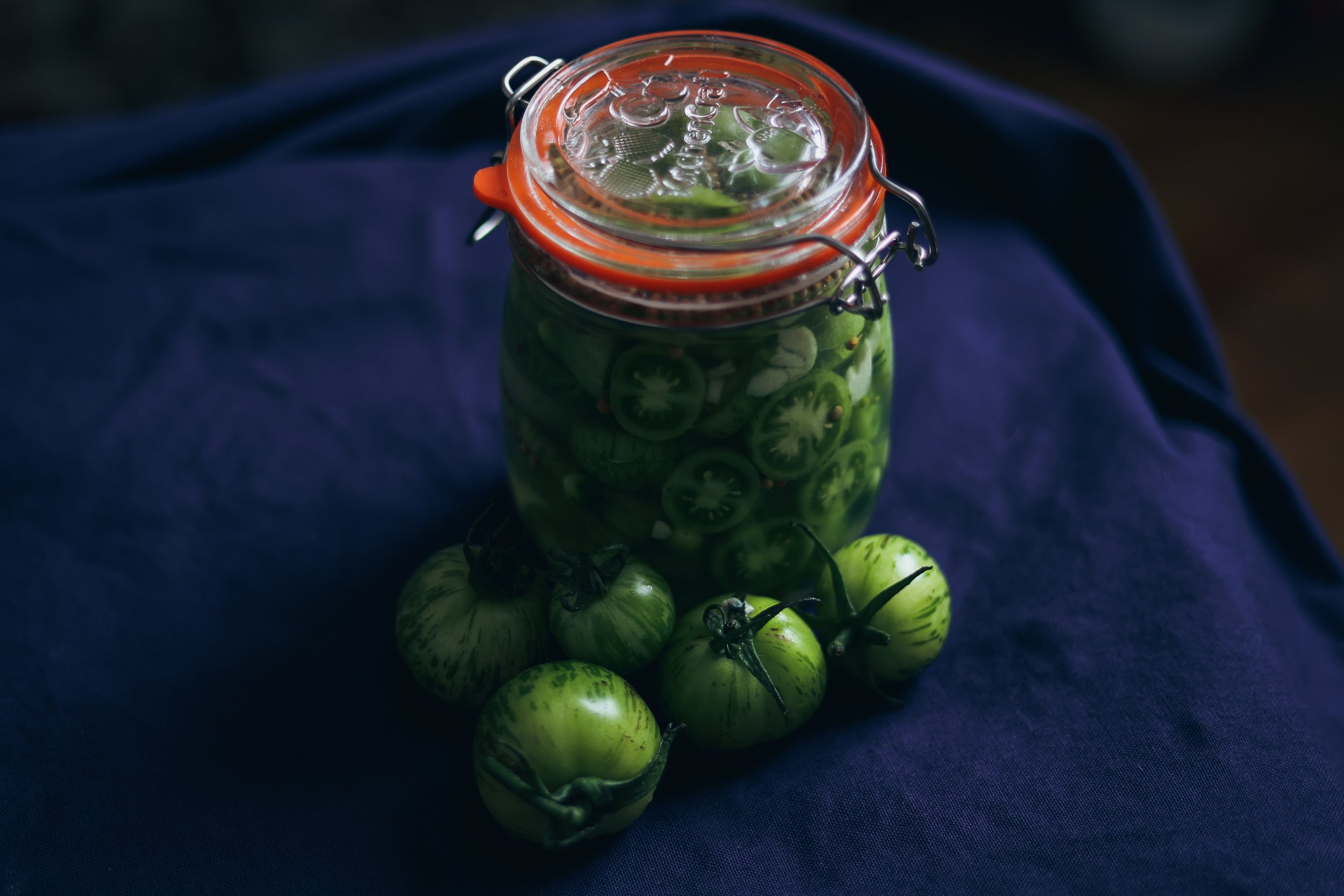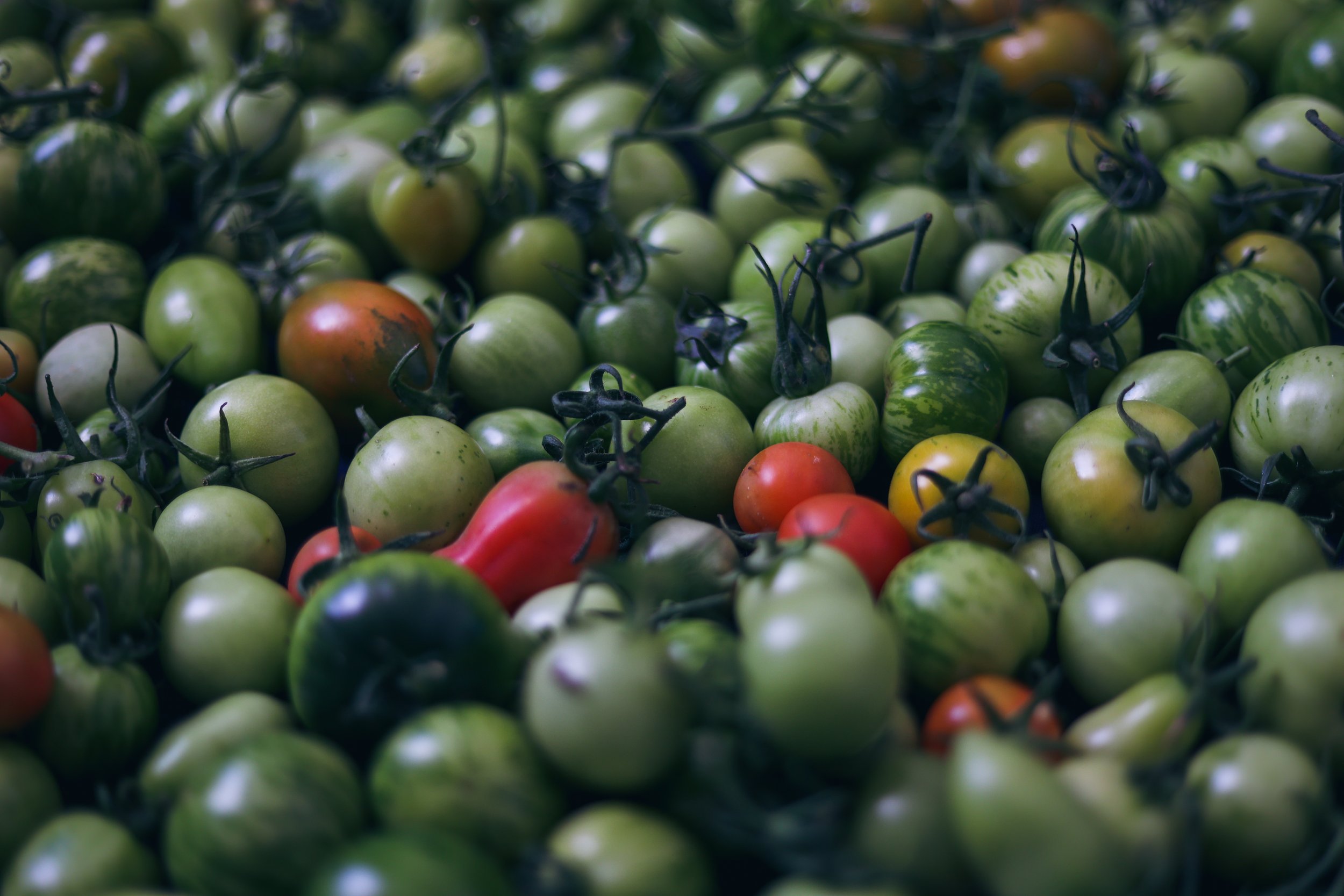Lacto Green Tomatoes
This quick fermented recipe only takes two weeks to transform your green tomatoes, often rescued from blight or frost, from unripe and astringent, to acidic green gems of flavour that lend themselves perfectly to sandwiches, stews, salads, salsas, or grilled and added to burgers. Because of the nature of green tomatoes, the sugars and juices haven’t developed yet, giving them an appley / almost aubergine texture. This makes them thirsty for fluid and perfect for grilling with oil and aromatics, or infusing with a herbal or spiced fermenting brine.
Depending on how you look at this crop, it can either be a nuisance or a delicacy. Over the next week I plan to publish three recipes for green tomatoes to help you make the most of your harvest. One will be a chutney, another is a quick green tomato salad, and the third is this, a half way between the two.
Lacto Fermentation
For those of you unfamiliar with the term lacto fermentation, it is a broad technique for fermenting with microbes that produce lactic acid as they break down sugars. If you’ve ever eaten sauerkraut or kimchi then you’ve eaten a lacto ferment. They’re acidic, tangy, and have unlocked flavours that are transformed from the original flavour of the raw ingredients thanks to the probiotic activity of the microbes.
The microbes themselves are a collection that come under the broad term LAB, lactic acid (producing) bacteria, and in most instances are already present on the food before we prepare it for fermentation. LAB can tolerate a salt solution of 2% and the absence of oxygen, two things that a lot of harmful microbes can’t. So, by adding 2% salt of the total weight of the jar’s ingredients (including the water) and keeping a lid screwed on tightly, we provide the perfect conditions for LAB to work it’s magic, acidifying the food, furthering it’s resilience to unwanted intruders.
Given time, usually 1-2 weeks, and an ambient temperature of around 17-27C / 62-80F, the microbes will prepare a wonderfully simple, healthy, and tasty ingredient that we can then move to the fridge and store for 1-2 months as we eat it.
Lacto Green Tomatoes
445g Green tomatoes, sliced 1cm thick across the fruit
355g Water
16g Non-iodised salt
2 Cloves of garlic, sliced
2g Coriander seeds
Optional: Add spices, herbs, or aromatics like ginger and shallots
Step 1.
Gently rinse your tomatoes under cold running water. The aim is to remove dirt but not scrub them as this will remove a lot of the microbiology. Sterilize the jar with boiling water, then tare your scales to the weight of your empty jar. Slice the green tomatoes, making sure to remove any vine or flower petals and fill the jar. Thinly slice the garlic and add it along with the coriander seeds.
Note: If you wish to unlock a stronger infusion from the coriander then toast the seeds first, or heat part of the water up in a saucepan with the coriander seeds in it (but make sure to cool it again before adding it to the jar).
Step 2.
Fill the jar with cold water and check the total weight. It should be roughly 800g. In lacto ferments, we always aim for around 2% salt ratio, so this recipe needs 16g. Weigh it in a small bowl, then tip some of the water in and dissolve it. We only need equal weight salt and water to fully dissolve all the salt. Now tip the brine back into the jar and close the lid. Give it a shake to distribute the salt evenly and check to make sure none of the tomato or garlic is sticking out of the water.
Step 3.
Leave the jar somewhere room temperature, out of direct sunlight, for 1-2 weeks, burping the jar daily to release the buildup of carbon dioxide. During this time, the increase in acidity will discolour the tomatoes, turning them more yellow. After the first week, crack the jar open and try one of the tomatoes. If you like it less acidic then move the jar to the fridge after the first week, but if you prefer something more tangy then leave it ambient for the full 2 weeks.





